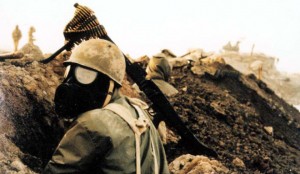 In 1988, near the end of the long Iran-Iraq war, Saddam Hussein's regime launched massive poison gas attacks against Iran, killing and maiming thousands of people. Iraq was at the time a US ally. Iranians still remember the moment they realized Iraqi warplanes were dropping more than regular bombs.�
In 1988, near the end of the long Iran-Iraq war, Saddam Hussein's regime launched massive poison gas attacks against Iran, killing and maiming thousands of people. Iraq was at the time a US ally. Iranians still remember the moment they realized Iraqi warplanes were dropping more than regular bombs.�The United States provided Iraq with intelligence on preparations for an Iranian offensive during the Iran-Iraq war even though it knew Baghdad would respond with chemical weapons.
"As Iraqi attacks continue and intensify the chances increase that Iranian forces will acquire a shell containing mustard agent with Iraqi markings," a top secret CIA report said in November 1983.
"Tehran would take such evidence to the UN and charge US complicity in violating international law," the agency warned.
Death from mustard gas is gruesome; so is survival. It hideously disfigures skin, sears lungs and mucus membranes, and often blinds. Unlike nerve gas, there�s no antidote.
Hassan Hassani Sa�di then an 18-year-old fighting in the Middle East�s grisliest modern war � the 8-year conflict between Iran and Iraq � survived the Iraqi attack on the strategic Fao Peninsula in 1985. Within hours, his body was badly blistered, and he had gone blind. �The last thing I remember is vomiting green,� he says, during an interview at the Tehran Peace Museum, a facility dedicated to education and the documentation of weapons of mass destruction.
Iran is today the world�s largest laboratory for the study of the effects of chemical weapons, because of the sheer numbers of Iranian victims.
In 1991, a declassified CIA report estimated that Iran suffered more than 50,000 casualties from Iraq�s repeated use of nerve agents and toxic gases in the 1980s. Mustard gas � in dusty, liquid and vapor forms � was used the most during the war. It was packed into bombs and artillery shells, then fired at frontlines and beyond, including at hospitals.
Years after the war, however, Iranian doctors noticed that respiratory diseases with unusual side-symptoms � corneal disintegration, rotting teeth and dementia, a combination synonymous with mustard gas � had started killing off veterans who had not always been on the frontlines. Civilians were also dying.
US sanctions have complicated treatment, Iranian doctors say. Humanitarian goods are technically exempt, but international banks have often been unwilling to conduct financial transactions with Iran.
Numbers have since soared from the lingering, and unanticipated, effects of mustard gas. Dr. Shahriar Khateri, Iran�s leading expert on chemical weapons victims, now says 70,000 are registered, many from low-dose exposure that is now killing them.
�We now know that the latency period can be 40 years,� says Khateri, who is unsure of his own fate.
Iranian doctors say the final toll of Iraq�s chemical weapons could ultimately rival the 90,000 who died from toxic gases in World War I.
By The Voice of Russia�
The Iran Project is not responsible for the content of quoted articles.











